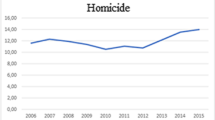Abstract
The purpose of this paper was to evaluate the impact of the Thai Prevention and Suppression of Prostitution Act of 1996 in ten geographical regions of the country. This paper also addresses law enforcement approaches in controlling prostitution. Data for prostitution arrests from 1995 to 1998 were obtained from official police sources (Statistics of Reported Crimes of Thailand). ARIMA intervention analysis was employed; revealing the arrest rates of prostitutes between pre- and post-enactment of the present Prostitution Act did not differ statistically within the regions except for Region 8 (Phuket). The paper reaches two general conclusions: (1) the 1996 Thai prostitution law did not significantly reduce the arrest rate for prostitution across the country; and (2) further consideration must be given to the idea of decriminalizing prostitution, which might allow for licensure, improving health and living conditions as well as potentially limiting exploitation and impact crimes associated with the prostitution industry.



Similar content being viewed by others
Notes
The estimated average monthly salary of working class Thai citizen is 7,000 Baht (approximately US $200).
A factor that limits this assumption is that police work against prostitution differs from area to area and from year to year.
The population in the ten regions varies across the 4 years of the study, based on the data from the Office of National Statistics of Thailand.
The time-series analysis disregarded the last 10 days of December 1996 for the post intervention impact since daily data was not available.
The proportions of prostitute arrests per total arrests from 1995 to 1998 in Bangkok were around 1/26, 1/36, 1/143, and 1/67, respectively; in Region 4 (Khonkhaen) were around 1/111, 1/333, 1/333, and 1/500, respectively; in Region 5 (Chiang Mai) were around 1/77, 1/100, 1/333, and 1/333, respectively; and in Region 7 (Huahin) were around 1/91, 1/200, 1/250, and 1/250, respectively.
The proportions of prostitute arrests per total arrests from 1995 to 1998 in Region 1 (Nonthaburi) were around 1/111, 1/333, 1/1000, and 1/167 respectively; in Region 2 (Pattaya) were around 1/38, 1/71, 1/63, and 1/83 respectively; in Region 3 (Nakhon Ratchasima) were around 1/167, 1/333, 1/91, and 1/111, respectively; in Region 6 (Tak) were around 1/125, 1/167, 1/167, and 1/1,000, respectively; in Region 8 (Phuket) were around 1/77, 1/91, 1/45, and 1/29, respectively; and in Region 9 (Songkhla) were around 1/40, 1/59, 1/53, and 1/35, respectively.
Pathumthani, Chonburi, Nakhornratchasrima, Khonkhaen, Chiangrai and Chiangmai, Tak, Prajuabkhirikhan, Suratthani and Phuket, and Songkhla
References
Bachman, R., & Schutt, R. K. (2001). The practice of research in criminology and criminal justice. Boston: Pine Forge.
Belinda, B. G. (2005). Clients and commercial sex: Reflections on paying the price: a consultation paper on prostitution. Criminal Law Review, 425–443.
Campbell, D. T., & Stanley, J. C. (1963). Experimental and Quasi-experimental Designs for Research. Chicago: Rand McNally College.
Caporaso, J. A. (1973). Quasi-experimental approaches to social science: Perspectives and Problems. In J. A. Caporaso & L. L. Roos Jr. (Eds.), Quasi-Experimental Approaches: Testing Theory and Evaluating Policy (pp. 1–36). Chicago: Northwestern University Press.
Charoenying, N. (1998). Problems and Needs of Prostitutes after Released from Proctection and Occupation Development Centre, Department of Public Welfare. Unpublished master’s thesis, Faculty of Social Science and Humanities, Mahidol University, Thailand.
Conant, M. (1996). Federalism, the MANN Act, and the imperative to decriminalize prostitution. Cornell Journal of Law and Public Policy, 5(99), 1–18.
Cromwell, J. B., Labys, W. C., & Terraza, M. (1994). Univariate Tests for Time Series Models. Thousand Oaks: Sage.
Erickson, M. L., & Gibbs, J. P. (1979). On the percieved severity of legal penalties. The Journal of Criminal Law & Criminology, 70(1), 102–116.
Jeffrey, L.A. (2002). Sex and Borders. Gender, National Identity, and Prostitution Policy in Thailand. Hawaii: University of Hawaii Press.
Grasmick, H. G., & Bryjak, G. J. (1980). The deterrent effect of percieved severity of punishment. Social Forces, 59(3), 469–491.
McDowall, D., McCleaery, R., Meidinger, E. E., & Hay, R. A., Jr. (1980). Interrupted Time Series Analysis. Beverly Hills: Sage.
Miller, C. R., & Haltiwanger, N. (2004). Crime and punishment law chapter: Prostitution and the legalization/decriminalization debate. Georgetown Journal of Gender and the Law, 5(207), 1–36.
Nagin, D. (1998). Criminal deterrence research at the outset of twenty-first century. In M. Tonry (Ed.), Crime and Justice: A Review of Research (Vol. 23, pp. 1–42). Chicago: University of Chicago Press.
Neave, M. (1988). The failure of prostitution law reform. Australian and New Zealand Journal of Criminology, 21(4), 202–213.
Police Information and Technology Center (PITC). (2006). Statistics of Reported Crimes of Thailand. Bangkok, Thailand.
Rhodes, R., & Zachman, P. (1991). Death in the candy store. Rolling Stone, 618, 62–71.
Scot, W., Benedikt, F., & Cheryl, W. (2002). Vice lessons: A survey of prostitution offenders enrolled in the Toronto John School Diversion Program. Canadian Journal of Criminology, 44(4), 369–402.
Shively, M., & Wheeler, K. (2009). A national overview of U.S. sex trafficking and prostitution demand reduction efforts. Paper presented at the Annual Meeting of the Academy of Criminal Justice Sciences, 10-14 March 2009.
Sorajjakool, S. (2003). Child prostitution in Thailand: Listening to Rahab. New York: Harworth.
Sullivan, B. (1999). Prostituion law reform in Australia: A preliminary evaluation. Social Alternatives, 18(3), 9–14.
Sullivan, M. L. (2007). Making sex work: A failed experiment with legalised prostitution. North Melbourne: Spinifex.
Trends, S. P. S. S. (1999). SPSS Trends 10. Chicago: SPSS.
Author information
Authors and Affiliations
Corresponding author
Appendix
Appendix
Rights and permissions
About this article
Cite this article
Khruakham, S., Lawton, B.A. Assessing the Impact of the 1996 Thai Prostitution Law: A Study of Police Arrest Data. Asian Criminology 7, 23–36 (2012). https://doi.org/10.1007/s11417-010-9100-9
Received:
Accepted:
Published:
Issue Date:
DOI: https://doi.org/10.1007/s11417-010-9100-9




